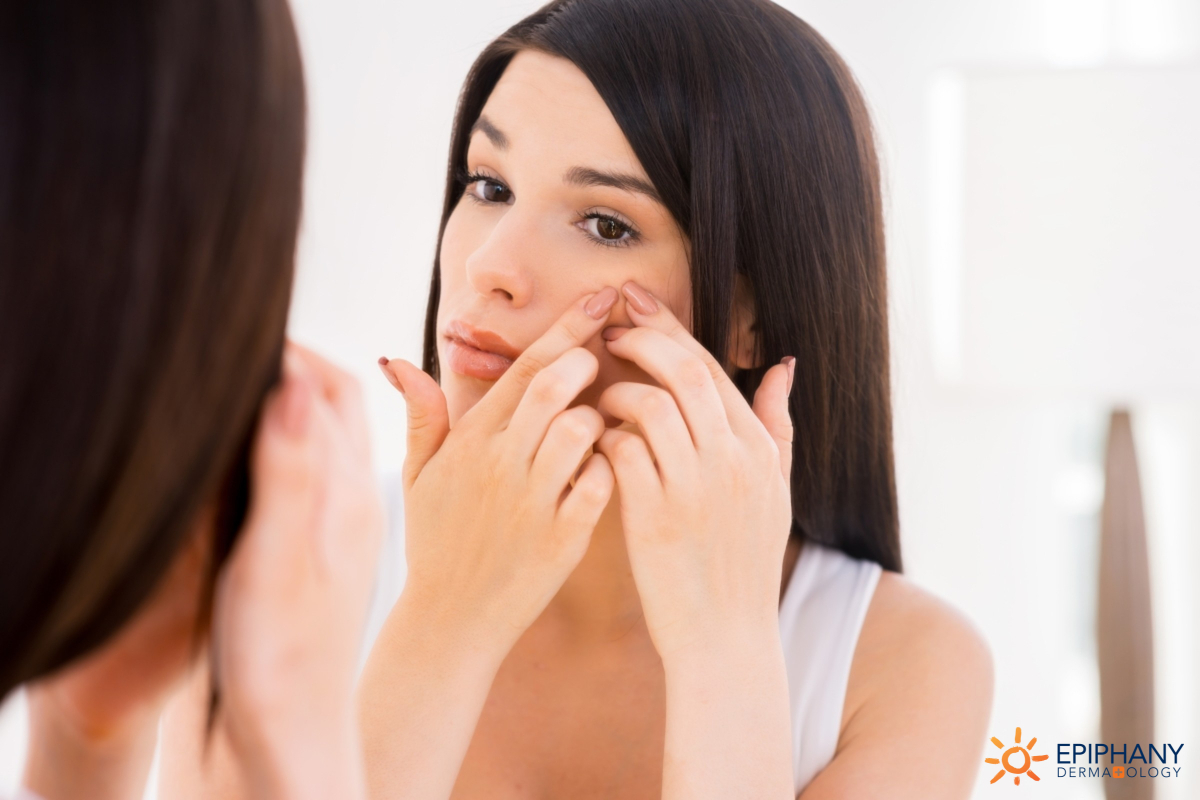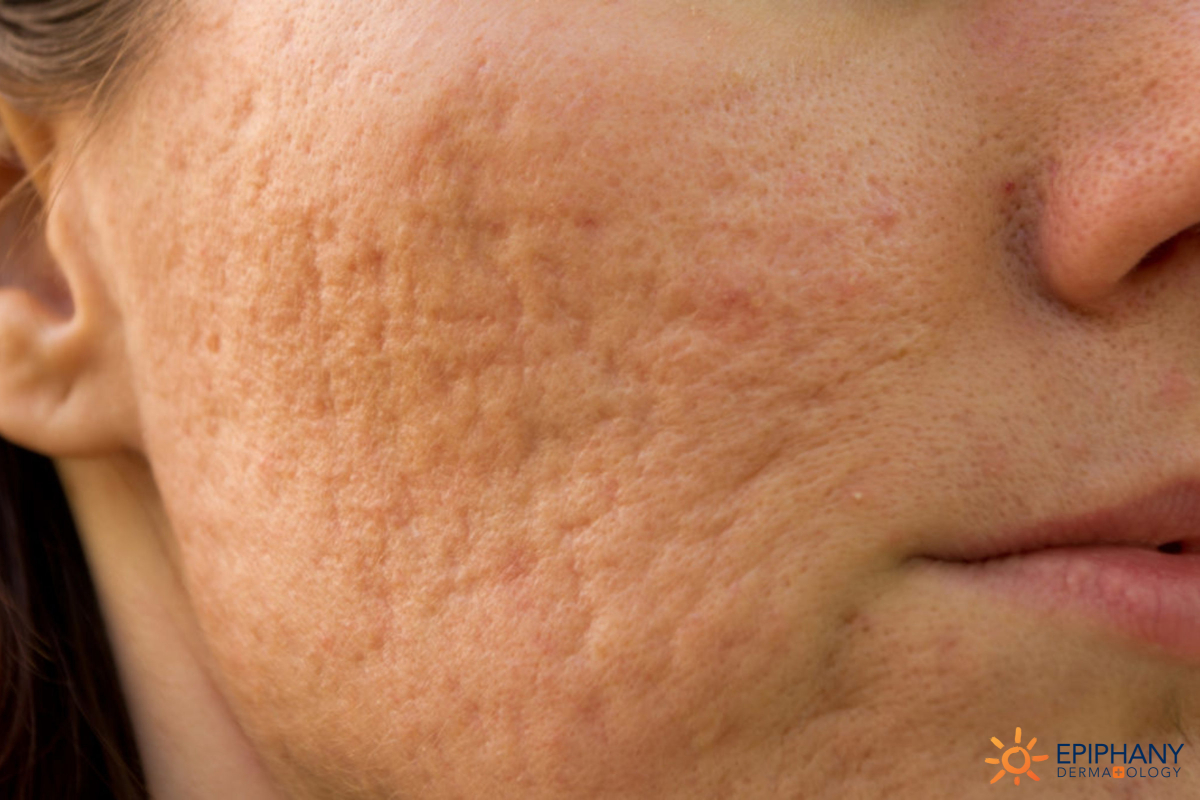Anyone who has really struggled with acne knows the frustration pimples bring. For some, it seems that no matter how much they wash their face, they just can’t make the bumps go away.
But, what’s worse than those glaring red pimples? The blemishes they leave behind. Thankfully, because of acne scar treatment, there’s no need to let acne scars cause any more frustration.
Acne Marks vs. Acne Scars
Most pimples leave behind evidence. Our hope is that their marks are superficial. If your skin remains smooth in dark or red areas, you simply have an acne mark. Those marks are not scars — they are just temporarily discolored. It usually takes 3-6 months for the marks to disappear.
However, if you have a scar, you’re dealing with permanent skin damage that needs treatment in order to disappear. An acne scar changes the texture of the skin. If acne has left indentations, or raised spots, the damage has occurred at a deeper level in the skin. This “cobblestoning” effect indicates scarring that needs more than a surface-level treatment.
Related: Tired of Hiding Acne Scars? Get the Skin You Deserve with Fractional Laser Scar Treatment
The best intervention for smooth skin is prevention. If you’re experiencing acne, you need to take steps to keep these scars from occurring. Treat new acne immediately, working with your dermatologist to find the best treatment option for you. And don’t pop pimples! You’ll just create more long-term damage.
If you notice that your skin remains bumpy after a pimple has cleared, visit your dermatologist for an early treatment plan. The ultimate goal is to stop the scars from forming.
What Causes Acne Scars?
Scars form when the skin is damaged. With acne inflammation, different types of blood cells and collagen rush to the point where injury may repair the skin. But they can’t always return the skin back to normal, especially when severe acne doesn’t give the skin time to heal before it breaks out again.
Types of Acne Scars
When you’re ready to treat your acne scars, your first step is identifying what type you have. You may have one specific scar that bothers you or a combination of multiple types of scarring.
So grab a mirror and see what best describes the scars you’re facing.
First, see what general type of scar you have. Is it:
- Depressed – Goes down into the skin
- Raised – Rises from the skin
- Discolored – Lighter, darker, or redder than your skin tone
Once you know the category of the scar, identify the specific type.
Depressed Scars
Also called “pitted” or indented acne scars, they go down into the skin. Some are rather shallow; others extend to the lower layers of the skin. These scars usually appear on the cheeks and forehead and most likely came from inflammatory acne. Here are the three specific kinds:
Rolling Scars
Rolling scars are broad depressions with sloping edges. They can be shallow or deep but most likely came from long-term inflammatory acne. As the skin ages, it loses elasticity and fullness, making rolling scars more pronounced.
Because the edges are rolling, these scars respond great to treatment.
Boxcar scars
These scars also left broad depressions in the skin, but the edges of the scar are sharply defined. Since the edges are steeper and more distinct from the surrounding skin, they’re more difficult to treat.
Ice Pick Scars
These deep, narrow scars often look like an open, enlarged pore, or an ice-pick wound. As the deepest depressed scar, it’s also the most difficult to treat.
Depressed scars respond best to more aggressive treatments. Fractional laser treatments, Intense Pulse Light phototherapy, and RejavaPen improve the skin’s texture after acne. However, the depth of the scar and steepness of the edges often determine how effective the treatment will be.
Raised Scars
If you have a raised scar, you likely had a cyst there before. As the cystic acne healed, too much scar tissue formed in its place. Now it’s a bulge of thick, rubbery scar tissue (called a keloid or hypertrophic scar) that protrudes from the skin.
These scars aren’t as common as other types, but if you have them, they’re likely on your chest, back, or jawline — where you had cystic acne.
Raised scars respond well to treatment. Laser resurfacing is especially effective in smoothing raised acne scars.
Discoloration
If you’ve had acne, you likely have skin discoloration. Discoloration isn’t technically a scar but is the most common side effect of acne. Whether brown, red, or white, the pigment in these areas isn’t the same as the rest of your skin tone. Often, the discoloration fades with time. But sometimes, the change in color becomes permanent.
There are three categories of discoloration — and treatment options for each!
If you have a brown discoloration, you’re dealing with hyper-pigmentation. The acne damaged the skin cells, and the cells that produce melanin (melanocytes) either multiplied or overproduced melanin in an effort to recover. Consequently, you ended up with a freckle-like spot that won’t go away.
There are several options for treating dark spots. We use laser and light treatments, hydroquinolone, or topical retinoids to reduce melanin production (so the pigment decreases) and increase cell turnover (so you can slough off the discolored skin).
Related: Retinol, Retin-A, & Retinoids: What’s the Difference?
Hypo-pigmentation is characterized by the light spots that result from a lack of melanin. With this type of skin damage, melanocytes are depleted from the injured area or lose their ability to produce melanin. This occurs when healthy skin has been replaced with scar tissue. Because scar tissue has a light pink color, it’s more noticeable on people with darker skin tones.
Few treatments completely erase hypo-pigmentation, but chemical peels and laser resurfacing can be helpful in creating a more balanced skin tone.
Erythema is a permanent redness that comes from damaged skin cells. Small capillaries near the surface of the skin become permanently dilated, resulting in a red spot. It’s common in acne patients and most visible in lighter skin.
For treatment, we can prescribe a topical medication to decrease vasodilation temporarily, or work toward more long-term solutions with Intense Pulse Light phototherapy.
What Acne Scarring Is NOT
An acne scar is a change in texture in your skin. Usually, it’s depressed. It’s not a brown spot. Discoloration is temporary, but texture changes are permanent.
This bumpy texture, also known as cobblestoning, starts when a pimple creates an indentation. If you notice a low spot form from a pimple, get the dermatologist ASAP. The more aggressively you treat this type of acne, the less likely you are to deal with the long-term effects of acne scarring.
The Best Acne Scar Treatment
Scars form because collagen fills in damaged skin areas in a column pattern that mimics the wound. The collagen binds the skin, but it also pulls the skin down and contracts it making it a different texture from surrounding skin.
In scar treatments, we break up the collagen. Then, as it re-grows, it comes back more randomly and the web of collagen produces smoother skin. If you’re living with scars, we have two primary treatments for breaking up the collagen and rejuvenating your skin.
Rejuvapen for Acne Scars
The most cost-efficient treatment is the Rejuvapen for acne scars. The Rejuvapen uses needles to pierce the collagen and change the pattern of the scar. The collagen then reforms in a different arrangement as the skin heals.
Laser Treatment for Acne Scars
Our second primary treatment, the Icon Laser, offers patients the best results for smoother skin. Laser therapy breaks up the scar with laser light. It punches holes in the collagen without ever piercing the skin. Because it doesn’t break the skin, recovery tends to be quicker after this treatment. Also, lasers penetrate deep into the skin causing long-lasting results.
The costs of laser treatments for acne scars vary drastically. Depending on the area and the type of laser you need, the costs of laser treatment for acne scars range from a few hundred to a few thousand dollars.
Why Is Dermatological Treatment Recommended for Acne Scars?
When you have true scars that have changed the texture of your skin, you’ll need a medical procedure to see improvement. We use a laser specifically approved by the FDA for treating laser scars. Some people try chemical peels, which aren’t very effective. Others try dermabrasion, a technique like a sanding wheel on your skin, but there’s a high risk of permanent scarring. A laser gets much better results without the same risk.
Schedule an Acne Scar Treatment Today
If you’re ready to start the process of removing your scars, rest assured, you’re in good hands. For an acne scar treatment in Dallas, just give us a call and we’ll help you choose the treatment that’s best for you.
We start with a consultation. An esthetician will examine your skin to determine your skin type and the severity of your scarring. Then they’ll decide how many treatments you’ll need. Typically, dark skin requires more treatments. Because dark skin is more prone to produce pigment, we reduce the amount of energy for each treatment. That way, you’ll avoid dark pigmented areas after your treatment.
You’ll also learn how to prepare for your treatment. We’ll give you products to apply before your procedure to prime your skin and avoid pigmentation. You’ll also receive information on pain medication and the downtime you’ll need as you recover. If you decide to take time off work, you can schedule your procedures before a weekend or take a few days off.
After your treatment, have your sunscreen ready. You’ll need to apply it heavily in the weeks following your procedure to avoid over-pigmentation.
If you’re a victim of acne scars, there’s no need to live with skin blemishes of the past. Laser treatments work at a deep level to leave you with beautiful smooth skin, and Rejuvapen delivers great results at a fraction of the cost. Contact us to discover the best choice for your skin!

Dr. R. Todd Plott is a board-certified dermatologist in Coppell, Keller, and Saginaw, TX. His specialization and professional interests include treating patients suffering with acne, identifying and solving complex skin conditions such as psoriasis, rosacea, atopic dermatitis, and identifying and treating all types of skin cancers. In his spare time, Dr. Plott enjoys cycling, traveling with his wife, and spending time with his children and new grandson.
Learn more about Dr. Plott.



